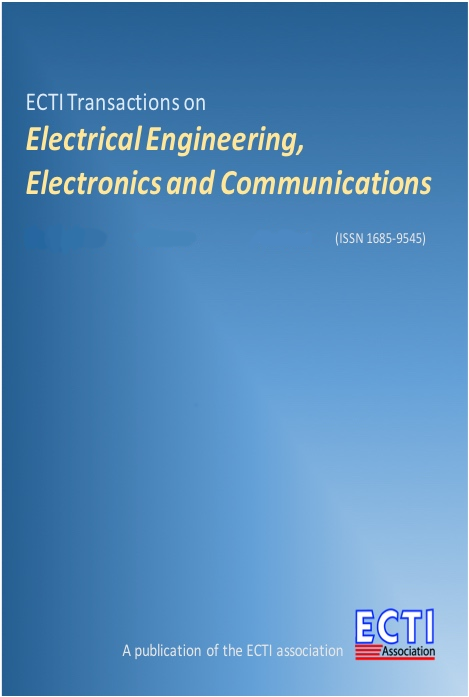Texture Based Classification of Malaria Parasites from Giemsa-Stained Thin Blood Films
Main Article Content
Abstract
Quantification of parasitemia is an important part of a microscopic malaria diagnosis. Giemsa-stained thin blood smear is the gold standard method for detecting malaria parasite enumeration. However, manual counting reveals the limitations of human inconsistency and fatigue, as well as the unreliability of accuracy and non-reproducibility. Inaccurate parasitemia affects clinical diagnosis and therapeutic procedure. Automated quantification is therefore useful to improve the performance of quantifying parasite density. In this paper, the texture-based classification approach is investigated. The methods consist of the following processes: pre-processing, segmentation, feature extraction and the classification of erythrocytes. The pre-processing is applied for image conversion and enhancement. The segmentation combines local adaptive thresholding, morphological process and watershed transform to extract red blood cells, separate touching and overlapping cells. Texture analysis is performed to establish parameters obtained from first-order, second-order and higher-order statistical analysis and wavelet transform. Two feature selection approaches, the sequential forward selection method and sequential backward elimination method, integrated with a support vector machine classifier are examined to obtain the optimal feature set for identifying the Plasmodium falciparum stages. We found that gray-level co-occurrence matrices based textural features were highly selected. The optimal feature set selected by the sequential forward selection yields lesser number of features and tends to give a higher degree of accuracy than the feature set selected by sequential backward elimination. The proposed method produces 98.87% accuracy for binary classification, 99.56% accuracy for ring stage classification, and 99.48% accuracy for tropozoite stage classification. Grey-level co-occurrence matrices based texture analysis is the dominant method compared to first-order and higher-order statistical texture analysis as well as wavelet transform.
Article Details
This journal provides immediate open access to its content on the principle that making research freely available to the public supports a greater global exchange of knowledge.
- Creative Commons Copyright License
The journal allows readers to download and share all published articles as long as they properly cite such articles; however, they cannot change them or use them commercially. This is classified as CC BY-NC-ND for the creative commons license.
- Retention of Copyright and Publishing Rights
The journal allows the authors of the published articles to hold copyrights and publishing rights without restrictions.
References
[2] P. Puttapirat, M. Phothisonothai and S. Tantisatirapong, “Automated segmentation of erythrocytes from Giemsa-stained thin blood films,” Proceeding of 8th International Conference on Knowledge and Smart Technology, Thailand, 2016.
[3] S.W.S. Sio, W. Sun, S. Kumar, W.Z. Bin, S.S. Tan, S.H. Ong, H. Kikuchi, Y. Oshima and K.S.W. Tan, "MalariaCount: an image analysis-based program for the accurate determination of parasitemia," J. Microbiol. Methods, Vol. 68, pp. 11-18, 2007.
[4] Y. Purwar, S.L Shah, G. Clarke, A. Almugairi and A. Muehlenbachs, “Automated and unsupervised detection of malarial parasites in microscopic images,” Malaria Journal, Vol.10, 2011.
[5] S.S. Savkare and S.P. Narote, “Automatic system for classification of erythrocyte infected with malaria and identification of parasite’s life stage”, Procedia Technology 6, pp.405 – 410, 2012.
[6] G. Díaz, F.A. González, and E. Romero, “A semi-automatic method for quantification and classification of erythrocytes infected with malaria parasites in microscopic images," Journal of Biomedical Informatics, Vol. 42, pp. 296-307, 2009.
[7] F.B. Tek, A. G. Dempster , I. Kale, “ Parasite detection and identification for automated thin blood film malaria diagnosis,” Computer Vision and Image Understanding, Vol.114, pp. 21–32, 2010.
[8] W.Preedanan, M.Phothisonothai, W.Senavongse, and S.Tantisatirapong, “Automated detection of plasmodium from Giemsa-stained thin blood films,” Proceeding of 8th International Conference on Knowledge and Smart Technology, Thailand, 2016.
[9] B. Malleret, C. Claser, A.S.M. Ong, R. Suwanarusk, K. Sriprawat, S.W. Howland, B. Russell, F. Nosten, L. Rénia, “A rapid and robust tri-color flow cytometry assay for monitoring malaria parasite development,” Scientific Reports, Vol.1, pp.118, 2011.
[10] K. Silamut, N.H. Phu, C. Whitty, G.D.H. Turner, K. Louwrier, N.T.H. Mai, J.A. Simpson, T.T. Hien, N.J. White, “A quantitative analysis of the microvascular sequestration of malaria parasites in the human brain”, The American Journal of Pathology, American Society for Investigative Pathology, Vol. 115(2), pp. 395-410, 1999.
[11] G. Xiong, Local Adaptive Thresholding - File Exchange - MATLAB Central. from http://www.mathworks.com/matlabcentral/fileexchange/8647-local-adaptive-thresholding.
[12] F. Malik and B. Baharudin, “The statistical quantized histogram texture features analysis for image retrieval based on median and laplacian filters in the DCT domain,” The International Arab Journal of Information Technology, Vol. 10, No. 6, November 2013.
[13] R. M. Haralick, K. Shanmugam and I. Dinstein, “Textural features of image classification,” IEEE Transactions on Systems, Man and Cybernetics, Vol. SMC-3, No. 6, Nov. 1973.
[14] L. Soh and C. Tsatsoulis, “Texture analysis of SAR sea ice imagery using gray level co-occurrence matrices,” IEEE Transactions on Geoscience and Remote Sensing, Vol. 37, No. 2, March 1999.
[15] DA. Clausi, “An analysis of co-occurrence texture statistics as a function of grey level quantization,” Can. J. Remote Sensing, Vol. 28, No.1, pp. 45-62, 2002.
[16] X. Tang, “Texture information in run-length Matrices,” IEEE Transactions on Image Processing, Vol. 7, No. 11 pp. 1602-1609,1998.
[17] X. Wei, Gray Level Run Length Matrices Toolbox v1.0, Software, Beijing Aeronautical Technology Research Center, 2007.
[18] H. Peng, L. Fuhui and C. Ding, “Feature selection based on mutual information: criteria of max-dependency, max-relevance, and min-redundancy,” IEEE Transactions on Pattern Analysis and Machine Intelligence, Vol. 27, No.8 pp. 1226-1238, 2005.
[19] S. Tantisatirapong and M. Phothisonothai, “Classification of in vitro blood stages of plasmodium falciparum based on fuzzy interference system,” Proceeding of 10th International Conference on Knowledge and Smart Technology (KST), Chiang Mai, 2018, pp. 293-296.

